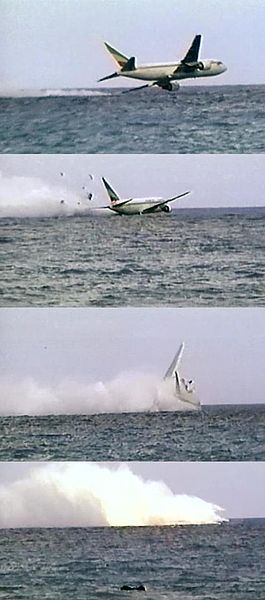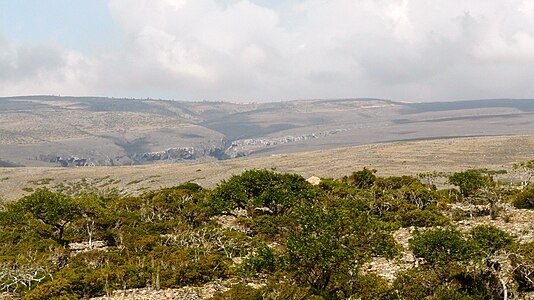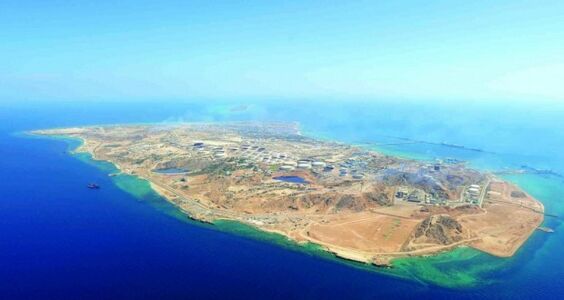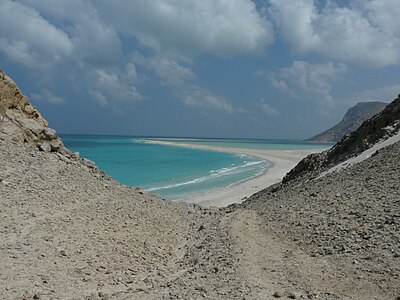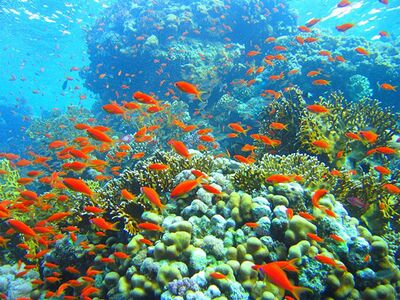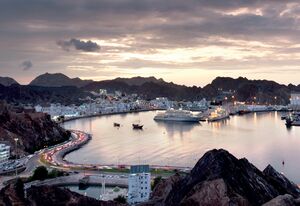Khazal Islands
Khazal Islands Union Territory
| |
|---|---|
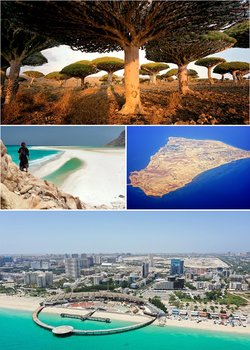 | |
 Location of the Khazal Islands Union Territory in red. | |
| Country | |
| Established | 1976 |
| Capital | Evazeh |
| Government | |
| • Governor | Nikahang Kowsar |
| Area | |
| • Total | 3,250 km2 (1,250 sq mi) |
| Population (2019) | |
| • Total | 30,583 |
| • Rank | 12th in Zorasan |
| Time zone | UTC 0, UTC +1 |
The Khazal Islands (Pasdani: جزایر خزعل; Jazâyir-e Khazal; Rahelian: جزر خزعل; Jazāʾir al-Khazal), officially known as the Khazal Islands Union Territory (Pasdani: قلمرو اتحادیه جزایر خزر; Sarzamin-ye Ettehad-ye Jazâyir-e Khazal; Rahelian: إقليم اتحاد جزر الخزر; Al-Iqlīm al-Ittiḥād Jazāʾir al-Khazal), a union territory of Zorasan, are a group of 23 islands of which 3 are inhabited at the etrance of the Gulf of Parishar.
The territory is located about 170km north of the Ashkezar Peninsula and island, and its eastern edge is located about 230km west of the Sakhnin Peninsula in Tsabara. It is bound to the north by the Solarian Sea and to the south, the Gulf of Parishar. The islands are divided into four distinct groups; to the south is the island of Evazeh, the largest and only to be permamently populated. The island is surrounded by smaller volcanic islands formed over 15 million years ago and surface-breaking rocks and shoals. The second group is located north of Evazeh and is comprised of four large islands, three of which are artifical islands, constructed throughout the 1980s by dredging the seabed around local sandbanks. The largest of this group is Manār Island, which is home to a semi-permament population of fishermen and their families, the second largest is Pasdar Island, which was expanded by dredging in the 1990s and houses an airfield and military personnel. To the north is Shimorgh Island, which houses a scientific facilities and is popular for scuba divers, and finally to the east is the Borj Islands, which are small outcroppings and artifically expanded sandbars. The Borj islands are uninhabited but do house support structures for fishermen and civilian contractors.
The union territory's capital is Evazeh, which is home to 20,104 people and has become a popular exclusive tourist resort. The total land area of the islands is approximately 3,250 km2 (1,250 sq mi). The entire territory is governed as a singular district, with Evazeh maintaining authority over the territory's archipelagos. The union territory is unique compared to others, as its governance is also subject to direct involvement by the Zorasani military owing to its strategic location, as such, the territory is home to the Khazal General Command, the only inter-service geographical command in the country.
History
First inhabitants
In 1956, an archaelogical study of Evazeh island discovered evidence indicating that the island had seen human activity as early as 2,500 BC. Several pieces of pottery and fossilised pieces of carbonised wood, indicating some form of camp fire was discovered. Attempts at classifying the pottery in relation to civilisations to in Eastern Satria, Zorasan or Tsabara were made but failed to assign a civilisation for its creation. In 1958, a second study of the island discovered several ruins located in a valley at the centre of the island. The ruins were later identified to be the walls and floor of a Zoroastrian Fire Temple, the design and construction methods corresponded to the Sorsanid Empire (550 BCE-400 BCE), which in turn confirmed the records of Bozorgmehr, a Sorsanid era poet who wrote of a "paradise of the sea to the north of the homeland." Historians believe that Evazeh had a human population intermittently throughout the classical and middle ages.
Gorsanid presence

In 1211 CE, the Gorsanid Empire established a permament outpost on Ezaveh, establishing the foundations of the future city of the same name. During this period, the settlement was mostly home to fishermen and pearl hunters. The island was also used as a safe haven for merchant ships crossing the Solarian Sea between the Gorsanid Empire and Euclea. In 1280, the Gorsanids constructed a small stone-fort overlooking the city and its population is believed to have reached 3,500 by 1300.
Povelian presence
In 1385, in response to escalating piracy by ships and crews paid by the Gorsanid Shah to attack Povelian shipping during the Wars of the Sea, the island of Ezaveh was seized by Povelian forces under the command of Cesare Enzignerio-Favri. The island would remain under Povelian control over sixty years, during which time little to no change was recorded to everyday life on the island. The only difference to be noted was the expansion of the fort and the establishment of a smaller outpost on Manar Island, mostly as a waypoint for Povelian galleys and traders. In 1445, the Gorsanids retook the island of Evazeh and destroyed the outpost on Manar Island, they in turn again expanded the fort on Ezaveh and would retain control of the island until 1828.
Etrurian colonial presence
In 1828, the United Kingdom of Etruria seized the islands of the modern day union territory in the First Etrurian-Gorsanid War. They seized the island following the destruction of the Gorsanid fleet at the Battle of Bayadha and a short bombardment of Evazeh's fortress. Following its capture, the island was militarised by the Etrurian empire in an effort to secure its use as a springboard to further incursions into the Gorsanid Empire and to maintain a permament presence in the southern end of the Solarian Sea. Between 1830s and 1850s, the island was developed and saw an increase its population, rising from the centuries-long average of roughly 3,500 to well over 9,000 by 1855. Roads were constructed across the island and it became a popular destination for botonists, biologists and naturlists owing to its unique flora and fauna. In 1886, a coaling station was constructed and the harbour of Evazeh was deepened to support larger merchant vessels and warships. This was followed by the construction of a telegraph station and network across the island, elevating Evazeh as a key mid-way station for the Etrurian Navy.
During the Khordad Rebellion (1918-1921) the island of Evazeh became home to an internment camp for rebellious Irfanic clerics and senior figures of the rebellion. With the introduction of oil boilers aboard vessels, the coaling station on Evazeh slowly fell out of use being abandoned in 1929. During the Great War, Evazeh became a stop-off point for ships of the Etrurian Navy and a midway point for supply convoys supporting Etrurian forces against the Entente in Coius and Rahelia. During the Solarian War, the island was bombed by Estmerish Navy aircraft. And following the war's end was transferred to the Shahdom of Pardaran.
Union of Khazestan and Pardaran
The islands' transfer to the Shahdom in 1946 saw little to no government or military activity and the population of the islands slowly declined. Evazeh between 1946 and 1948 would become essentially a self-governing community until forces of the Pardarian Revolutionary Resistance Command seized islands in the latter stages of the Pardarian Civil War. With the estbalishment of the Union of Khazestan and Pardaran in 1953, interest and investment in the islands increased dramatically. In 1954, the Inter-Services Command of the Khazal Islands was established and a small airstrip was added to Pasdar Island, followed by a lengthening of the runway on Evazeh. A small naval facility was constructed during the late 1950s to accomodate vessels of destroyer size.
The discovery of off-shore oil and gas fields in the Gulf of Parishar again brought further investment to the islands, with Ezaveh becoming a hub for geologists, seismologists and civil contractors. Residential areas, a powerplant and an expansion to the islands' port during the 1960s resulted in the population rising from 8,000 to 18,000 by 1970. In the year's leading up to the Irvadistan War, the UKP instituted a significant military build up on the small islands beyond Evazeh. Pasdar Island was enlarged through dredging and saw the constructon of a radar installation and defensive structures, in 1973, Pasdar was formally declared off-limits to civilians and anti-ship missile batteries were deployed to the island.
During the Irvadistan War, the islands were used by the UKP military to launch air attacks against Irvadi shipping between 1975 and 1977, before being expanded to Tsabaran military and civilian maritime targets. On the 18 April 1978, Pasdar Island was attacked by Tsabaran aircraft resulting the Battle of Pasdar Island. Three Tsabaran aircraft were shot down by UKP fighter aircraft launched from Evazeh, two days later, the TNS Tabbessa, a naval frigate was attacked and sunk by land-based missile batteries on Pasdar Island. In 1979, the UKP defeated the United Rahelian People's Republic and Tsabara, culminating in the completion of Zorasani Unification and the founding of the Union of Zorasani Irfanic Republics, investment into the islands continued throughout the 1980s, with expansion to islands in the Borj group and investments into Ezaveh as a tourist spot.
Modern
From 1980 until 1993, the investments into the islands was maintained, with expansions to the Borj group to facilitate the construction of key installations and a coast guard outpost. Significant funds were invested into Evazeh to establish it as a high-quality tourist hotspot. The airfield was expanded to receive short-haul and medium-haul airliners, while new hotel resorts were constructed on the southern side of the island. Between 1993 and 1996, Shimorgh Island was expanded by over 2 square miles and saw the construction of roads and a heliport, Euclean militaries also noted the construction of a radar installation and defences, though no military equipment or systems were deployed.
In 1996, AirParishar Flight 901 crashed off the beach of southern Evazeh within the sight of several thousand tourists and remains one of the few airline disasters to be caught on tape. The aircraft suffered catestrophic engine failure and was ditched in the Gulf of Parishar 300 meters from the coast. A total of 111 passengers and crew were killed in the disaster and 61 people survived, aided by Zorasani emergency services and tourists who swam out to assist.
In 1999, construction began on the Evazeh Shahanshah Grand Hotel Resort and would not be completed until 2008. The project would become the most expensive resort ever built in Zorasan, with costs as high as €860 million. When opened, the resort was awarded a five-star rating and as of 2020, remains the highest rated resort by both critics and tourists. The construction aligned with a boom in tourism to Evazeh and Shimorgh Island, which has become a popular destination for tourists and scuba divers. Private investments surpassed state led-development in expanding the entertainment and cultural facilities on Evazeh, with the opening of an aquarium, dolphinarium and water park in the early 2010s, followed by smaller resorts and hotels.
In 2020, owing to rising geopolitical tensions over the Tsabaran Civil War, the Zorasani military began to re-militarise the Pasdar and Shimorgh islands, with the deployment of aircraft and missile systems.
Geography
The territory is located about 170km north of the Ashkezar Peninsula and island, and its eastern edge is located about 230km west of the Sakhnin Peninsula in Tsabara. It is bound to the north by the Solarian Sea and to the south, the Gulf of Parishar.
The islands are divided into four distinct groups; to the south is the island of Evazeh, the largest and only to be permamently populated. The island is surrounded by smaller volcanic islands formed over 15 million years ago and surface-breaking rocks and shoals. The second group is located north of Evazeh and is comprised of four large islands, three of which are artifical islands, constructed throughout the 1980s by dredging the seabed around local sandbanks. The largest of this group is Manār Island, which is home to a semi-permament population of fishermen and their families, the second largest is Pasdar Island, which was expanded by dredging in the 1990s and houses an airfield and military personnel. To the north is Shimorgh Island, which houses a scientific facilities and is popular for scuba divers, and finally to the east is the Borj Islands, which are small outcroppings and artifically expanded sandbars. The Borj islands are uninhabited but do house support structures for fishermen and civilian contractors.
Evazeh, the largest island (439 km2; 169 sq mi) is mostly flat on the southern half before rising in altitude with the Evazeh Heights, large rock outcroppings and escarpments (some reach as high as 190m; 623ft above sea level) that dominate the northern half of the island to the coast. The capital of the union territory, Evazeh is located on the southern side of the island, surrounding a natural harbour. To the west of Evazeh is a series of smaller resorts and communities, and to the east are privately owned residences and beachside villas. The Evazeh Territory Airport is located north of the capital bewtween the coast and the Evazeh Heights. The interior of Ezaveh is dominated by unique flora and fauna endemic only to the island. The eastern and northern coasts of Evazeh are line with coral reefs, while the southern shore saw a dramatic decline in its coral reefs due to overdevelopment.
Pasdar, Shimorgh and many of the Borj islands are flat, lacking mountains or even high hills, on average the elevation of the other islands in the territory is 35–40 m (115–131 ft) above sea level, though several of the artificial islands in the Borj group are notably lower in elevation than others. All the islands with the exception of Evazeh lack vegetation of any kind, except for those imported by residents.
Pasdar Island is off-limits to civilians and is officially under a military exclusion zone.
Climate
The islands of the territory have a very dry semi-equatorial climate. Between 2010 and 2018, the average annual rainfall in Evazeh was 135 mm (5.3 in) and the median annual temperature was 28.6 °C (83.4 °F). In the months from October to April, Ezaveh's weather is mild, ranging from 18 °C (64 °F) to 25 °C (77 °F). Compared to the coastal areas of northern Zorasan and southwestern Tsabara, the islands of the territory have the most sunny hours in the region, approximately 3,200 hours per year. The islands location amid hot air and relatively shallow waters (the Gulf of Parishar is on average 50 m (160 ft) deep), means the islands tend to be hot and humid most of the year.
Flora and fauna
Evazeh's long geological isolation from the Coian mainland and its hot climate has produced unique endemic species of flora. The most iconomic of Evazeh's endemic plants is the Azdar tree (Dracaena cinnabari), the ood-looking umbrella-shaped tree found in the island's dry interior. Another iconic plant of Evazeh is the Pillar Tree, a tree with a bulbous trunk and small crown. Widely used and important in ancient times was the island's endemic aloe plants, which were used medicinally and for cosmetics. Sorsanid records talk of precious aloes being used in the comestics of nobles and the courts of Kings during the empire, while records from the First Heavenly Dominion, spoke of Evazeh being used as a means to gather "plants in treatment of the soldiers of God."
The island was once home to hundreds of endemic species that have since been forced into extinction by human activity on Evazeh. Montecaran traders in the 15th century wrote of encountering water buffaloes, though this is disputed. The only mammal to be native to the island are bats. The island of Evazeh is home to numerous endemic bird, insect and marine species.
Governance and politics
As a union territory, the islands are governed directly by the Zorasani federal government. Owing to the islands' small population, its federal representation is provided by the Ashkezar-Ezaveh District, making it the sole district to be found in both a Union Republic (Pardaran) and a Union Territory.
The governor of the territory is appointed by the First Minister and confirmed by the Popular Assembly. However, owing to the strategic location of the territory and the militarised areas, the Central Command Council has the final confirmation vote on appointments. According to the Union Constitution, the CCC may also remove the First Minister appointed incumbent and replace him or her with a military officer in times of emergency. The current governor is Nikahang Kowsar, who was appointed by First Minister Farzad Akbari in 2017.
The "Territorial Council" with Councillors as representatives of the people is constituted to advise the Governor on local matters. The Territorial Council has 18 members elected by first-past-the-post in single-member constituencies located across the populated islands. The Territorial Council also manages the budget, public services (refuse collection, roads, utilities) and local tax rates.
Economy
Energy
Another key area of the territory's economy is energy. In the early 2000s, several of the Borj Islands were developed to play a role in the off-shore oil and gas industry, notably the construction of holding tanks and support facilities. Borj 4 for example maintains an onshore hospital, heliport and command centre for oil rig workers operating in the Gulf of Parishar.
Tourism
Since the mid-1980s, the Zorasani government has embarked on an promotional and developmental campaign to promote Evazeh has an exclusive tourist destination, to both domestic and international markets. The campaign has included massive construction projects of hotels, resorts, entertainment venues, shopping malls, cultural sites and infrastructure. The morality codes on the island are more relaxed than on the Zorasani mainland, most notable codes on gender mixing, clothing and public behaviour. As a result, Evazeh is host to numerous musical events that would otherwise be barred on the mainland. Despite investments into the infrastructure, the island remains highly exclusive, drawing mostly middle-class urban domestic tourists and wealther international clientel. In 2019, the Zorasani government announced state subsidised packages for state workers to the island.
In the territory capital, the main places to visit are the Old Fortress, Sorsanid Ruins, Evazeh Water sports complex, Evazeh Aquatheatre, Evazeh Bird Sanctuary, Doge's Cove and Al-Aṣfūr Island for Scuba diving/snorkeling/sea walking and the beached "Amathian Ship", which is a rusted shipwreck of an Amathian flagged cargo vessel that beached in 1962 during bad weather. It is popular divers and swimmers and is within view from Mo'jeze beach.
Fishing
Fishing remains a highly lucerative industry in the territory. Traditional forms of fishing utilised by residents of Evazeh takes place alongside industrial-scale fishing conducted by large companies based on the Borj and Shimorgh islands, who utilise large long-endurance trawlers. Evazeh is also renowned for its traditional industry of pearl hunting, but in recent years, pearl farming has emerged on Shimorgh Island. An estimated 20% of the territory's workforce is for fishing.
Infrastructure
The connection with the territory is carried out either by sea or by air through Evazeh International airport and Evazeh Port, though smaller maritime connections to the other islands do exist. Evazeh International Airport serves as the entry point for the hundreds of thousands of tourists who come to Evazeh, while the airport also operates a smaller helicopter service that connects the capital to other islands of the territory. The airport can receive most short-haul and medium-haul airliners, as a result long-haul flights require a connecting flight from Borazjan International Airport on the mainland.
Maritime connections are focused on the Port of Evazeh, which is a natural deep water harbour. Historically, maritime connections to the mainland were conducted through the harbour in Evazeh City, however, demand overstretched the established facilities and further expansion was unachievable. Between 2000 and 2006, a larger facility was constructed to the northwest of the island, and is capable of receiving freighters, heavy trawlers and some cruise vessels of medium tonnage. Ferry services are operated from this facility to other islands of the territory.
In 2012, a new 15-megawatt gas fired powerplant was completed on the western side of Evazeh, some distance away from the tourist resorts to avoid an eyesore. The powerplant supplies the entirety of Evazeh with energy without interruption, prior to this, smaller generators were required to fuel the various resorts and hotels, with fuel being imported form the mainland on a monthly basis. These generators are still required on the other populated islands (Shimorgh and Pasdar).
Internet
The territory for much of the late 1990s and 2000s have limited and unreliable access to the internet, as they required satellite links for connection, it became a regular criticism of residents and businesses in the territory. In 2010, the Zorasani federal government invested funds into a project to connect the territory by fibre optic cable to the mainland via the Ashkezar Peninsula. The project was completed in 2012 and was inaugurated by State President Hamid Alizadeh. In 2013, the submarine cable was extended to connect Evazeh to the other populated islands.



